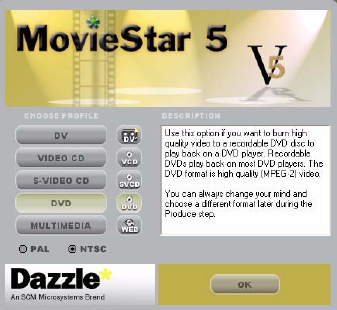
Hollywood DV-Bridge User’s Guide • Using Hollywood DV-Bridge With a PC • Page 22
Capturing Video
To capture DV or analog video to your computer’s hard disk, follow the steps below (for
more detailed instructions on capturing video, see your MovieStar 5 User’s Guide).
Note: It is important not to launch MovieStar 5 before all the hardware devices are
connected!
1. Launch MovieStar 5.
The Project Profile dialog box appears. In this window, you can choose the type of
project you want to create, for example, making a DVD. Choosing the project profile at
this point speeds the video editing process, but you can always change your mind and
choose a different profile later. If you want to create an analog video tape, choose DVD
for your project profile. For a DV video tape, choose DV. In this window, you can also
select a broadcast standard (NTSC or PAL).
2. Choose a project profile, then click OK.
3. Click the Capture button to display the Capture window.
4. Enter a name for your file, then select a file destination.
5. Select Hollywood DV-Bridge as the video device.
If you are using a camcorder and capturing from a previously recorded tape, set the
camcorder to Video Tape Recorder mode. If you want to capture live video from the
camcorder, set it to Camera mode. For analog video captures, the Hollywood DV-Bridge
converts the analog video to DV. For DV captures, the DV video passes through the
Hollywood DV-Bridge. After the capture operation, the video is stored on your
computer’s hard disk.
6. Specify whether you want to capture from the Composite (RCA), S-Video, or 1394
input.
7. Go to the point on the tape where you want to begin capturing.
The video image appears in the Player window in MovieStar 5.
